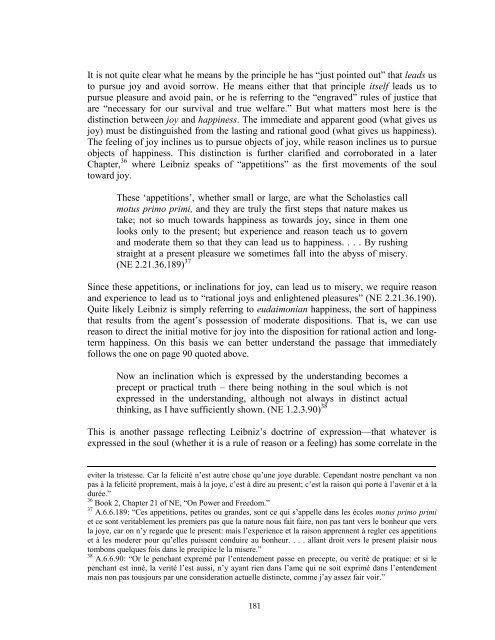Stony Brook University
Stony Brook University
Stony Brook University
You also want an ePaper? Increase the reach of your titles
YUMPU automatically turns print PDFs into web optimized ePapers that Google loves.
It is not quite clear what he means by the principle he has “just pointed out” that leads us<br />
to pursue joy and avoid sorrow. He means either that that principle itself leads us to<br />
pursue pleasure and avoid pain, or he is referring to the “engraved” rules of justice that<br />
are “necessary for our survival and true welfare.” But what matters most here is the<br />
distinction between joy and happiness. The immediate and apparent good (what gives us<br />
joy) must be distinguished from the lasting and rational good (what gives us happiness).<br />
The feeling of joy inclines us to pursue objects of joy, while reason inclines us to pursue<br />
objects of happiness. This distinction is further clarified and corroborated in a later<br />
Chapter, 36 where Leibniz speaks of “appetitions” as the first movements of the soul<br />
toward joy.<br />
These ‘appetitions’, whether small or large, are what the Scholastics call<br />
motus primo primi, and they are truly the first steps that nature makes us<br />
take; not so much towards happiness as towards joy, since in them one<br />
looks only to the present; but experience and reason teach us to govern<br />
and moderate them so that they can lead us to happiness. . . . By rushing<br />
straight at a present pleasure we sometimes fall into the abyss of misery.<br />
(NE 2.21.36.189) 37<br />
Since these appetitions, or inclinations for joy, can lead us to misery, we require reason<br />
and experience to lead us to “rational joys and enlightened pleasures” (NE 2.21.36.190).<br />
Quite likely Leibniz is simply referring to eudaimonian happiness, the sort of happiness<br />
that results from the agent’s possession of moderate dispositions. That is, we can use<br />
reason to direct the initial motive for joy into the disposition for rational action and longterm<br />
happiness. On this basis we can better understand the passage that immediately<br />
follows the one on page 90 quoted above.<br />
Now an inclination which is expressed by the understanding becomes a<br />
precept or practical truth – there being nothing in the soul which is not<br />
expressed in the understanding, although not always in distinct actual<br />
thinking, as I have sufficiently shown. (NE 1.2.3.90) 38<br />
This is another passage reflecting Leibniz’s doctrine of expression—that whatever is<br />
expressed in the soul (whether it is a rule of reason or a feeling) has some correlate in the<br />
eviter la tristesse. Car la felicité n’est autre chose qu’une joye durable. Cependant nostre penchant va non<br />
pas à la felicité proprement, mais à la joye, c’est à dire au present; c’est la raison qui porte à l’avenir et à la<br />
durée.”<br />
36 Book 2, Chapter 21 of NE, “On Power and Freedom.”<br />
37 A.6.6.189: “Ces appetitions, petites ou grandes, sont ce qui s’appelle dans les écoles motus primo primi<br />
et ce sont veritablement les premiers pas que la nature nous fait faire, non pas tant vers le bonheur que vers<br />
la joye, car on n’y regarde que le present: mais l’experience et la raison apprennent à regler ces appetitions<br />
et à les moderer pour qu’elles puissent conduire au bonheur. . . . allant droit vers le present plaisir nous<br />
tombons quelques fois dans le precipice le la misere.”<br />
38 A.6.6.90: “Or le penchant expremé par l’entendement passe en precepte, ou verité de pratique: et si le<br />
penchant est inné, la verité l’est aussi, n’y ayant rien dans l’ame qui ne soit exprimé dans l’entendement<br />
mais non pas tousjours par une consideration actuelle distincte, comme j’ay assez fair voir.”<br />
181
















